Book contents
- Frontmatter
- Contents
- List of Illustrations
- Notes on Contributors
- Acknowledgements
- Introduction: The Fragile Contemporaneity of the Popular
- I Politics
- II Media
- III Affect
- 9 Affect, Politics and the Production of the People: Meditations on the Río Magdalena
- 10 The Politics of Emotion in the Mexican Revolution: The Tears of Pancho Villa
- 11 Memory and Affective Technologies in the Argentine Comic Book Series Cybersix
- Index
10 - The Politics of Emotion in the Mexican Revolution: The Tears of Pancho Villa
from III - Affect
Published online by Cambridge University Press: 05 October 2013
- Frontmatter
- Contents
- List of Illustrations
- Notes on Contributors
- Acknowledgements
- Introduction: The Fragile Contemporaneity of the Popular
- I Politics
- II Media
- III Affect
- 9 Affect, Politics and the Production of the People: Meditations on the Río Magdalena
- 10 The Politics of Emotion in the Mexican Revolution: The Tears of Pancho Villa
- 11 Memory and Affective Technologies in the Argentine Comic Book Series Cybersix
- Index
Summary
At the beginning of his seminal social history of the Revolution, Alan Knight describes Mexico on the eve of the outbreak of the civil war:
Mexico of 1910 was, borrowing Lesley Simpson's phrase, ‘many Mexicos’, less a nation than a geographical expression, a mosaic of regions and communities, introverted and jealous, ethnically and physically fragmented, and lacking common national sentiments; these sentiments came after the Revolution and were […] its offspring rather than its parents. (Knight 1986: vol. 1, 2; emphasis added)
The formation of national sentiments has become a key theme in the burgeoning critical literature devoted to the politics of popular culture in the post-revolutionary period. Commentators have analysed how, in the aftermath of the profound upheavals of a war in which peasants, workers and the middle classes made, albeit uneasy, common cause, they came to unite under the rubric of shared symbols, icons and discourses experienced as national (Vaughan and Lewis 2006). Culture, particularly those forms and practices designated as popular –folk artisanship and music, and mass media forms, such as the radio and cinema – participated in the transformation of Mexico from ‘a regionally, culturally fragmented country into a modern nation-state with an inclusive and compelling national identity’ (López 2010: 2). Far from being a top-down process, the cultural-political construct that emerged in this period ‘was shaped, resisted, and ultimately negotiated by a multitude of actors and interests, and lo mexicano came to serve counterhegemonic impulses as well as regime projects’ (Joseph et al. 2001: 8).
- Type
- Chapter
- Information
- Latin American Popular CulturePolitics, Media, Affect, pp. 249 - 270Publisher: Boydell & BrewerPrint publication year: 2013

